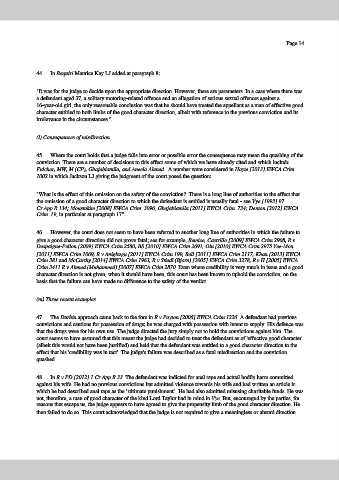Page 421 - Magistrates Conference 2019
P. 421
Page 14
44. In Baquiri Maurice Kay LJ added at paragraph 8:
"It was for the judge to decide upon the appropriate direction. However, there are parameters. In a case where there was
a defendant aged 37, a solitary motoring related offence and an allegation of serious sexual offences against a
16 year old girl, the only reasonable conclusion was that he should have treated the appellant as a man of effective good
character entitled to both limbs of the good character direction, albeit with reference to the previous conviction and its
irrelevance in the circumstances."
(l) Consequences of misdirection
45. Where the court holds that a judge falls into error or possible error the consequence may mean the quashing of the
conviction. There are a number of decisions to this effect some of which we have already cited and which include
Fulcher, MW, M (CP), Gbajabiamila, and Aneela Ahmed. A number were considered in Hoyte [2013] EWCA Crim
1002 in which Jackson LJ giving the judgment of the court posed the question:
"What is the effect of this omission on the safety of the conviction? There is a long line of authorities to the effect that
the omission of a good character direction to which the defendant is entitled is usually fatal see Vye [1993] 97
Cr.App.R 134; Moustakim [2008] EWCA Crim. 3096, Gbajabiamila [2011] EWCA Crim. 734; Denton [2012] EWCA
Crim. 19, in particular at paragraph 17"
46. However, the court does not seem to have been referred to another long line of authorities in which the failure to
give a good character direction did not prove fatal; see for example, Remice, Castrillo [2009] EWCA Crim 2908, R v
Despaigne-Pellon [2009] EWCA Crim 2580, BS [2010] EWCA Crim 2691, Olu [2010] EWCA Crim 2975 Yee-Mon
[2011] EWCA Crim 1069, R v Anigbugu [2011] EWCA Crim 199, Bell [2011] EWCA Crim 2117, Khan [2013] EWCA
Crim 381 and McCarthy [2014] EWCA Crim 1963, R v Stiedl (Bjorn) [2005] EWCA Crim 3278, R v H [2005] EWCA
Crim 3411 R v Ahmed (Muhammed) [2007] EWCA Crim 2870. Even where credibility is very much in issue and a good
character direction is not given, when it should have been, this court has been known to uphold the conviction, on the
basis that the failure can have made no difference to the safety of the verdict.
(m) Three recent examples
47. The Durbin approach came back to the fore in R v Payton [2006] EWCA Crim 1226. A defendant had previous
convictions and cautions for possession of drugs; he was charged with possession with intent to supply. His defence was
that the drugs were for his own use. The judge directed the jury simply not to hold the convictions against him. The
court seems to have assumed that this meant the judge had decided to treat the defendant as of 'effective good character'
(albeit this would not have been justified) and held that the defendant was entitled to a good character direction to the
effect that his 'credibility was in tact'. The judge's failure was described as a fatal misdirection and the conviction
quashed.
48. In R v PD [2012] 1 Cr.App.R.33. The defendant was indicted for anal rape and actual bodily harm committed
against his wife. He had no previous convictions but admitted violence towards his wife and had written an article in
which he had described anal rape as the "ultimate punishment". He had also admitted misusing charitable funds. He was
not, therefore, a man of good character of the kind Lord Taylor had in mind in Vye. But, encouraged by the parties, for
reasons that escape us, the judge appears to have agreed to give the propensity limb of the good character direction. He
then failed to do so. This court acknowledged that the judge is not required to give a meaningless or absurd direction.

